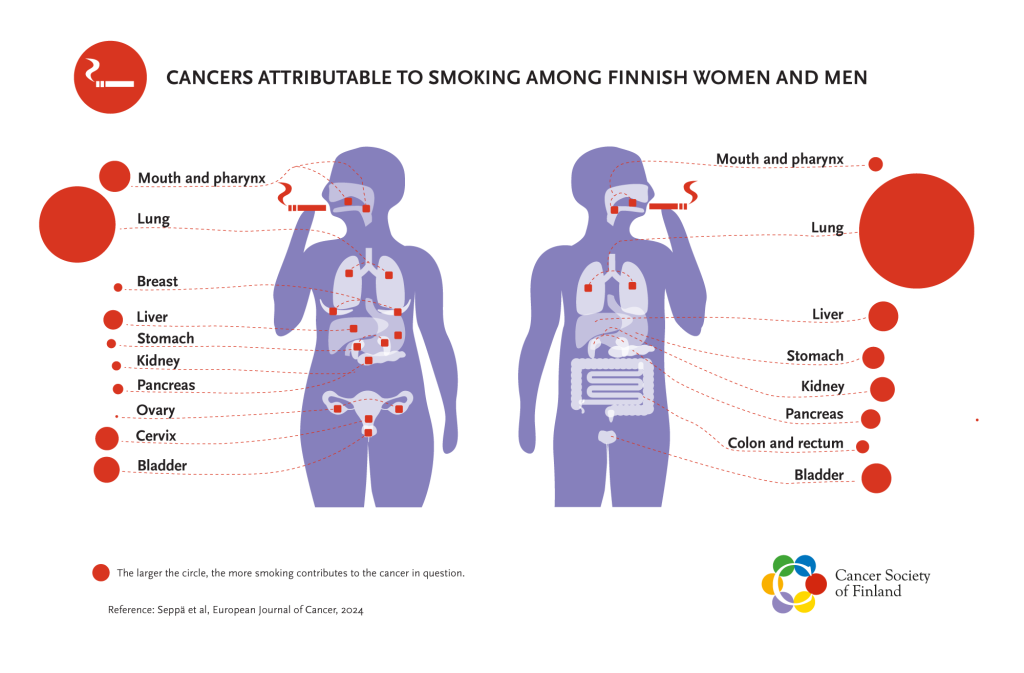
By: Karri Seppä
(Originally published by the Finnish Cancer Registry 14.03.2024 “Syyksilukuosuus paljastaa syöpätaakan merkittävimmät syyt“. English translation by Eetu Mäkinen)
Suomennos: Syyksilukuosuus paljastaa syöpätaakan merkittävimmät syyt
We cannot name what caused an individual cancer, but we know that different lifestyle-related risk factors explained 34 % of men’s and 24 % of women’s cancers in Finland over the last 40 years. Smoking caused 23 % of cancers in men and 8 % in women. Being overweight and alcohol use together caused approximately 10 % of cancers in both men and women. The figures mentioned are the proportions of the population’s cancer cases explained by different risk factors. It is a measure commonly used in epidemiology to illustrate the impact of a risk factor on public health. In practice, it answers the question of,
How large a proportion of cancer cases could be avoided if no one in the population was exposed to the given risk factor?
The population attributable fractions (PAF) depend on both the effect of the exposure on the probability of cancer and the prevalence of the exposure in the population.
Research has accumulated strong evidence on the causal effects of lifestyle risk factors
The examination of PAFs is focused on the lifestyles that can be considered to have a real causal effect on the origin of cancer. More information is gathered of the risk factors of cancer, and the International Agency for Research on Cancer (IARC) assesses based on the accumulated research evidence, whether the risk factors are true causal factors of cancer.
For many risk factors there is indeed strong evidence that they cause some types of cancers.

The effect of an exposure on the probability of cancer
Exposure to a risk factor increases the probability of getting cancer. The effect on the probability can be evaluated in a cohort follow-up study, in which the incidence of cancer in persons exposed and unexposed to the risk factor are compared, while simultaneously controlling the effect of other factors affecting the cancer risk.
For instance, on average, smokers die younger than non-smokers. Had they not smoked, their average lifespan would have been longer and a larger proportion of them would have had time to develop some type of cancer during their lifetime.

For an individual it is relevant how much an exposure to a risk factor affects the probability of getting cancer or dying from cancer. It has been estimated that on average 38 men out of 100 will get cancer during their lifetime. If PAF is assumed to be 34 %, the cumulative probability of developing cancer in a population not exposed to risk factors can be roughly estimated: 13 men out of 38 who got cancer would not have gotten cancer, so on average 25 men out of 100 get cancer in the part of the population with healthy lifestyles. In terms of cancer prevention measures, it is also essential to know how the general population is exposed to different risk factors.
PAF illustrates the impact of a risk factor on public health

PAF depends on both the exposure’s effect on the probability of developing cancer and its prevalence in the population. A common risk factor can substantially increase the cancer burden in the population, even if its impact on an individual’s cancer risk is relatively small. On the other hand, an exposure that substantially increases an individual’s risk of cancer may be rare in the population, in which case its importance to the population’s cancer burden is small. Therefore, when interpreting the results, the prevalence of an exposure in the population under study must always be considered. For instance, smoking caused 89 % of lung cancers in men but only 59 % of lung cancers in women. This does not mean that smoking is less dangerous in terms of lung cancer risk in women than in men, but instead that smoking has been much more common in the male population than in the female population.
In the METCA research project, we evaluate both the prevalence of exposures and the associated cancer risks based on several health study cohorts and the associated cancer and mortality information. This type of cohort-based examination enables particularly reliable estimates for PAFs since the information on the prevalence of the exposure and its effect on the risk of cancer and death are based on the same data.
Nevertheless, these effects might have been underestimated to some extent because the data did not include those who did not participate in the studies, and whose lifestyles are known to be less healthy in terms of cancer risk. Additionally, it can be difficult to find a group that is completely unexposed to a risk factor: for instance, non-smokers have been exposed to passive smoking, especially during the earlier years of the follow-up in this study.

The population attributable fractions are estimated for the so-called modifiable risk factors, i.e., for factors that an individual can influence with their lifestyle. It helps us understand how large a proportion of the population’s cancers would be avoided in a hypothetical situation where no one in the population was exposed to the risk factor in question. The objective is to find the most crucial risk factors in terms of the population’s cancer burden, to which cancer prevention acts should be targeted.
Want to learn more about the Finnish Center of Excellence in Tumor Genetics?
Subscribe to the blog and keep up to date with the latest posts for a peek into the everyday life in cancer research. You can also follow us on Instagram (@tumorgenetics) and Twitter/X! (@CoEinTG)
One thought on “Population Attributable Fractions Reveal the Most Substantial Causes of Cancer Burden”
Comments are closed.